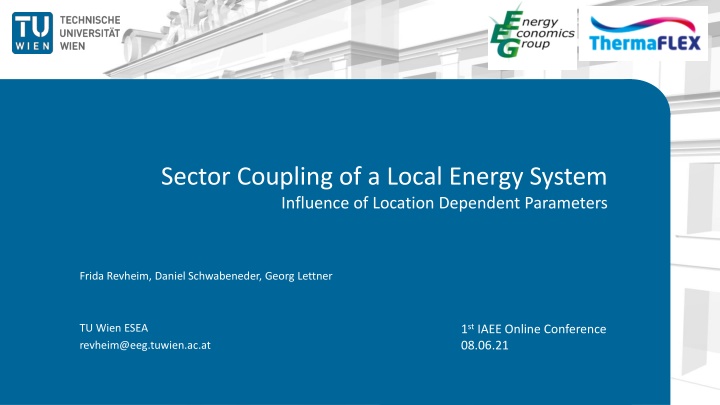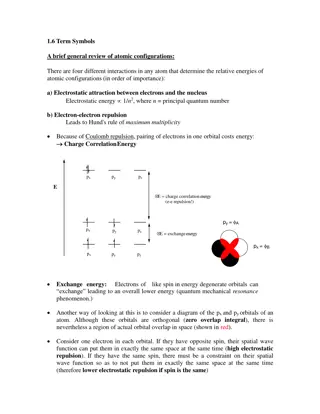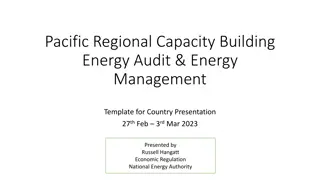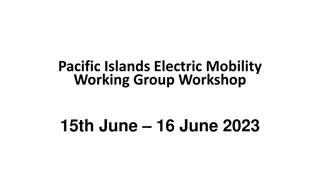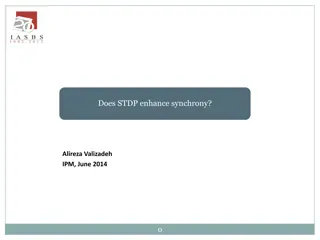Influence of Location-Dependent Parameters on Sector Coupling in Local Energy Systems
This study explores the impact of location-dependent variables on the sector coupling of local energy systems, focusing on factors such as electricity generation, energy demands, available fuel options, and more. The research aims to evaluate the profitability and operational efficiency of such systems in achieving renewable energy targets and reducing greenhouse gas emissions. By conducting a comparative analysis, the study investigates key performance indicators and optimization models to maximize system profitability while meeting energy demands.
Download Presentation

Please find below an Image/Link to download the presentation.
The content on the website is provided AS IS for your information and personal use only. It may not be sold, licensed, or shared on other websites without obtaining consent from the author.If you encounter any issues during the download, it is possible that the publisher has removed the file from their server.
You are allowed to download the files provided on this website for personal or commercial use, subject to the condition that they are used lawfully. All files are the property of their respective owners.
The content on the website is provided AS IS for your information and personal use only. It may not be sold, licensed, or shared on other websites without obtaining consent from the author.
E N D
Presentation Transcript
Sector Coupling of a Local Energy System Influence of Location Dependent Parameters Frida Revheim, Daniel Schwabeneder, Georg Lettner 1stIAEE Online Conference 08.06.21 TU Wien ESEA revheim@eeg.tuwien.ac.at
Introduction Introduction and motivation Methodology Model development Use cases Preliminary results Further work
Idea and motivation Sector coupling could be part of a solution to reach GHG emission targets Green hydrogen and green heat Curtailment reduction Potential benefits of sector coupling will depend on system location and location- specific variables Electricity generation Energy demands Available fuel options Comparative analysis is performed to evaluate the influence of location-dependent parameters on system operation and profitability Two key motivational factors: Ensure continued implementation and operation of RES Reduce GHG emissions 10.08.2024 3
Investigated KPIs Investigated KPIs: Profitability Degree of utilization of implemented technologies GHG emission reduction potential Renewable energy self-reliance External energy purchase Curtailment reduction 10.08.2024 4
Methodology model development Optimization model of sector coupled system developed in Julia Operational model, not considering investment costs Objective: optimize system operation to maximize profit, while meeting energy demands and following constraints at all times Revenues: Selling electricity to the electricity market Selling hydrogen to the gas market Selling hydrogen to industry/mobility Costs: Buying electricity to cover electricity demand Buying electricity to feed into heat pump Buying heat produced by alternative heat source to cover heat demand Buying natural gas to cover gas demand 10.08.2024 5
Methodology model development Investigated system includes both P2H and P2G technology Three different use cases Austria, Norway, Spain Location-dependent parameters as input for model Electricity generation from wind farm Local electricity, heat and gas demand Electricity prices, gas prices, price for alternatively produced heat Alternatives to green heat and the corresponding emissions Electricity mix 10.08.2024 6
Methodology use cases Spanish use case[1]: Municipalities of Isar,Las Quintanillas,Rab de las Calzadasandand Estepar Austrian use case[1]: Neusiedl am See region Norwegian use case[1]: fjord municipality 1961 households 4290 households 1000 households Wind farm with 57.5 MW installed capacity Wind farm with 32 MW installed capacity Wind farm with 31.5 MW installed capacity Majority of heat demand covered by electricity Majority of heat demand covered by gas Majority of heat demand covered by gas No gas demand considered No district heating demand considered 10.08.2024 xxx 7
Methodology scenarios Three scenarios investigated for each use case Scenario 1 Electricity demand electricity generated by wind farm and electricity bought from electricity market Heat demand heat bought from an alternative heat source Gas demand natural gas bought from the gas grid Scenario 2 Electricity demand electricity generated by wind farm and electricity bought from electricity market Gas-using customers assumed connected to district heating grid Heat pump scaled according to district heating demand Scenario 3 Electricity demand electricity generated by wind farm and electricity bought from electricity market Gas-using customers assumed switching to green hydrogen Heat pump scaled according to district heating demand Electrolyzer scaled according to gas demand Scenario 3 Wind farm Heat pump Electrolyzer Scenario 2 Wind farm Heat pump Scenario 1 Wind farm 10.08.2024 8
Results economic, AT use case Economic results - Austrian use case System is profitable in all investigated scenarios 5000 4000 3000 Introduction of electrolyzer significantly influences profit Monetary value [kEUR] 2000 1000 Introduction of heat pump reduces costs related to covering the heat demand 0 -1000 -2000 Total profit Revenue windmill Revenue electrolyser Total revenue Cost heat pump Cost Cost heat demand Cost gas demand Total cost electricity demand Austria Scenario 1 Austria Scenario 2 Austria Scenario 3 10.08.2024 9
Results economic, NO use case Economic results - Norwegian use case System is profitable in all investigated scenarios 4000 3500 3000 Slight increase in profitability due to heat pump implementation Monetary value [kEUR] 2500 2000 1500 No electrolyzer implemented (no gas demand) 1000 500 0 -500 Total profit Revenue windmill Revenue electrolyser Total revenue Cost heat pump Cost Cost heat demand Cost gas demand Total cost electricity demand Norway Scenario 1 Norway Scenario 2 Norway Scenario 3 10.08.2024 10
Results economic, ES use case Economic results - Spanish use case System is profitable in all investigated scenarios 3500 3000 2500 Slight increase in profitability due to heat pump implementation Monetary value [kEUR] 2000 1500 No heat pump implemented in scenario 3 (no district heating demand) 1000 500 0 -500 Total profit Revenue windmill Revenue electrolyser Total revenue Cost heat pump Cost Cost heat demand Cost gas demand Total cost electricity demand Spain Scenario 1 Spain Scenario 2 Spain Scenario 3 10.08.2024 11
Utilization of implemented technologies to cover demands Austria scenario 3 Overview of technology utilization in Austrian use case scenario 3 Generated electricity is either sold, used to cover demand or fed into electrolyzer Gas demand fully met by bought natural gas 10.08.2024 12
Utilization of implemented technology to cover heat demand Focusing on heat demand originally covered by district heating and gas Heat demand coverage in scenario 3 AT: Heat pump and electrolyzer NO: heat pump ES: electrolyzer Excluding heat demand covered by electricity 10.08.2024 xxx 13
Results KPI GHG emission reduction potential Significant emission reduction potential 5000 4474 4500 Reduced GHG emissions [ton CO2] 4000 Reduction depending on: Size of technology Electricity mix Alternative fuel (natural gas, bio pellets) 3500 2837 3000 2500 2000 1711 1650 1500 1070 968 968 968 1000 421 421 421 500 307 All green hydrogen sold to market no emission reduction achieved 0 0 0 0 0 0 0 0 0 0 0 0 0 0 Scenario 1 Scenario 2 Scenario 3 Scenario 1 Scenario 2 Scenario 3 Scenario 1 Scenario 2 Scenario 3 Austria Norway Spain Electricity demand Heat demand Gas demand 10.08.2024 14
Results KPI renewable energy self-reliance Electricity demand Majority of electricity demand covered by electricity generated by wind farm 100% 100% 100% 96% 96% 96% 100% 84% 81% Share of electricity demand covered 90% 80% by in-system renewable sources 70% 53% 60% 50% 40% 30% 20% 10% Implementation of electrolyzer reduces degree of electricity self-reliance 0% Scenario 3 Scenario 1 Scenario 2 Scenario 3 Scenario 1 Scenario 2 Scenario 1 Scenario 2 Scenario 3 Austria Norway Spain Introduction of heat pump can significantly affect degree of heat energy self-reliance Electricity generated by wind farm Heat demand 100% 88% 88% Share of heat demand covered by in- 90% 80% 54% 70% system renewable sources 60% 46% 38% 50% 40% 30% 20% 0% 0% 13% 0% 0% 0% 0% 0% 0% 10% 0% Scenario 1 Scenario 2 Scenario 3 Scenario 1 Scenario 2 Scenario 3 Scenario 1 Scenario 2 Scenario 3 Austria Norway Spain 10.08.2024 15 Heat produced by heat pump Waste heat from electrolysis
Results KPI external energy purchase Clear correlation with degree of energy self- reliance Energy bought from external sources 18000 17031 17031 16559 Energy purchased externally [MWh] 16000 14000 Coverage of gas demand fully dependent on natural gas purchase 12000 9697 9422 10000 8000 6000 Amount of electricity bought from the grid depend on utilization and size of implemented technologies 3688 4000 3200 3113 1524 1524 2000 1180 1180 1163 1034 826 128 128 3 3 3 0 0 0 0 0 0 0 0 Scenario 1 Scenario 2 Scenario 3 Scenario 1 Scenario 2 Scenario 3 Scenario 1 Scenario 2 Scenario 3 Austria Norway Spain Electricity Heat Natural gas 10.08.2024 16
Results KPI curtailment reduction Curtailment due to negative electricity prices No curtailment in NO and ES Curtailment reduced with heat pump and electrolyzer implemented REDUCTION OF CURTAILMENT IN AUSTRIAN USE CASE COMPARED TO SCENARIO 1 100% 90% 80% 70% 60% 46% 50% 34% 40% 30% 20% 10% 0% SCENARIO 2 SCENARIO 3 10.08.2024 17
Concluding remarks and further work Utilization of sector coupling concepts has the potential to reduce GHG emissions, increase degree of energy self-reliance and reduce curtailment Benefits of sector coupling depend on local conditions Further work could investigate Optimal system topology when considering investment costs Impact of local policy levers on influential parameters (e.g. electricity generation, energy demand, available fuel options) 10.08.2024 18
References and acknowledgements This work is done in the ThermaFLEX project [2] and is supported with the funds from the Climate and Energy Fund and implemented in the framework of the RTI-initiative Flagship region Energy within Green Energy Lab. [1] Energy Data, EuroStat, https://ec.europa.eu/eurostat/web/energy/data [2] ThermaFLEX, Green Energy Lab, https://greenenergylab.at/en/projects/thermaflex/ 10.08.2024 19
Frida Revheim TU Wien Energy Economic Group, EEG Gu hausstra e 25-29 / E370-3 1040 Vienna, Austria Thank you! Email: revheim@eeg.tuwien.ac.at Web: http://www.eeg.tuwien.ac.at
